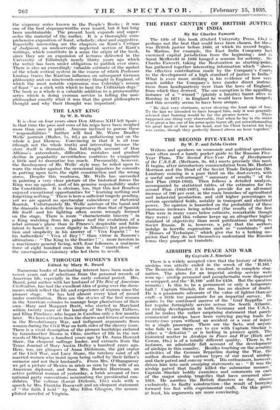AIRSHIPS IN PEACE AND WAR By Captain J. Sinclair
There is a widely accepted view that the history of British airships was utterly ended in the wreck of the 'R.101.' The Beauvais disaster, it is true, resulted in complete Stag- nation. The plans for an imperial airship service were torn up : airship personnel and paraphernalia were dispersed or scrapped, and the' R.100 'sold for /450. But the question remains : Is this to be a permanent or only a temporary halt ? Captain Sinclair, for one, has no shadow of doubt. He is a passionate advocate of the value of lighter-than-air craft—a little too passionate for an impartial survey. He points to the continued success of the Graf Zeppitlin ' on her regular fortnightly service across the South Atlantic, to airship development in both Germany and the U.S.A., and he makes the rather surprising statement that purely commercial airships have been carrying paying loads for twenty-two years without an accident or a case of injury to a single passenger. There are the facts, and anyone who fails to see them eye to eye with Captain Sinclair is either a " defeatist " or is lacking in pioneer spirit. The historical matter in Airships in Peace and War (Rich and Cowan, 18s.) is of a totally different quality. There is, for instance, an admirably full account of the development of airships in this country. 'Besides touching on the scouting activities of the German Zeppelins during the War, the author describes the various types of our naval airships and their patrol and convoy work. His enthusiasm, however, drives him into such sweeping statements as : "It was the airship patrol that finally killed the submarine menace." Captain .Sinclair boldly examines. and comments on each
of the major airship- that have occurred since 1918. He ascribes te British disasters as due, almost exclusively, to faulty 'construction--the result of hurrying forward too fast with experimental craft. On this paint, at least, his arguments are more convincing.










































 Previous page
Previous page